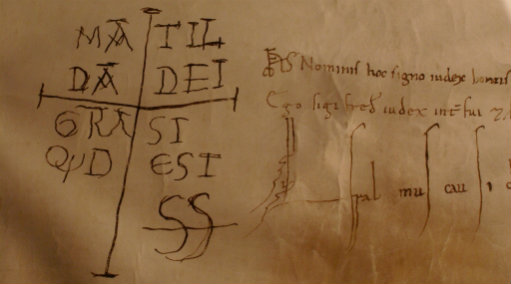Matilda of Canossa Exhibit Travels to Florence
The exhibition “Matilda of Canossa: The Woman Who Changed the Course of History” celebrates the 900th anniversary of the death of Matilda, Countess of Tuscany. It is on view at the Casa Buonarroti in Florence, Italy, from June 14 through October 10, 2016. The exhibition was produced in collaboration with William & Mary Law School. Essays by William & Mary President Taylor Reveley, Law School Dean M. Davison Douglas, Associate Professor of Law Thomas J. McSweeney and Adjunct Professor of Law Michèle Spike are published in the catalogue, in English and Italian.
The exhibition originated at the Muscarelle Museum at William & Mary (February 4 – April 29, 2015) where it was shown with “Leonardo Da Vinci and the Idea of Beauty.”
 Professor Spike said that those interested in the history of legal education may be interested to know of similar roles played by Matilda of Canossa and Thomas Jefferson, in different countries, and in different eras: Matilda of Canossa founded the first school of law at Bologna, in 1088 and Thomas Jefferson established the first chair in law in the United States at William & Mary in 1779. Both were motivated, she said, by the desire to train leaders to govern newly freed citizens – Italian communes as a result of Matilda’s policies; the American colonies as a result of Jefferson’s. As in Williamsburg, copies of editions of the Corpus Iuris Civilis and of the Institutes of Justinian, which are cited in Thomas Jefferson’s library, are on view in Florence.
Professor Spike said that those interested in the history of legal education may be interested to know of similar roles played by Matilda of Canossa and Thomas Jefferson, in different countries, and in different eras: Matilda of Canossa founded the first school of law at Bologna, in 1088 and Thomas Jefferson established the first chair in law in the United States at William & Mary in 1779. Both were motivated, she said, by the desire to train leaders to govern newly freed citizens – Italian communes as a result of Matilda’s policies; the American colonies as a result of Jefferson’s. As in Williamsburg, copies of editions of the Corpus Iuris Civilis and of the Institutes of Justinian, which are cited in Thomas Jefferson’s library, are on view in Florence.
The exhibition in Florence also displays original documents signed by Matilda and manuscripts created by her court which were not able to be shown in Williamsburg. These include an illustrated "Book of Psalms" dated 1090 and the Prayers and Meditations of St. Anselm, Archbishop of Canterbury, dated 1104, with a miniature of the Countess Matilda and the Archbishop of Canterbury. The exhibition in Florence also includes a 12th century manuscript of the "Institutes of the Emperor Justinian" and the original document dated March 1076 at Borgo Marturi, which cites the laws of the Emperor Justinian for the first time in centuries.
According to Professor Spike, Matilda revived the study of the 6th century laws of the Emperor Justinian because these laws, unlike the German feudal laws then in effect in Europe, granted women the rights to own, manage and inherit property in their own names. Matilda allied with papal Rome against the German kings. She revived the Roman laws of Justinian which gave her, and women after her, a colorable claim to inherit and to administer her paternal lands, which, in Matilda’s case, included most of Italy north of Rome. She revived trade, travel and pilgrimage and the art of architecture, by building over one hundred churches with hospices attached on the major medieval highways in her father’s lands.
Reviews of the exhibit in Florence have appeared in various newspapers including the STAMPA Toscana, June 2016, the Giornale dell’Arte, July-August, and in the Corriere della Sera, La Lettura, no. 240, July 3, 2016
About William & Mary Law School
Thomas Jefferson founded William & Mary Law School in 1779 to train leaders for the new nation. Now in its third century, America's oldest law school continues its historic mission of educating citizen lawyers who are prepared


